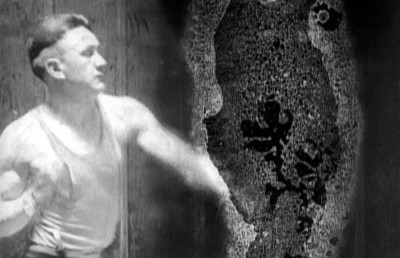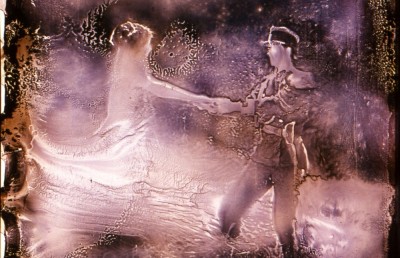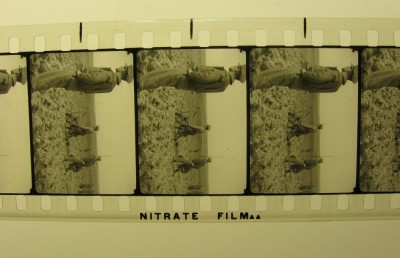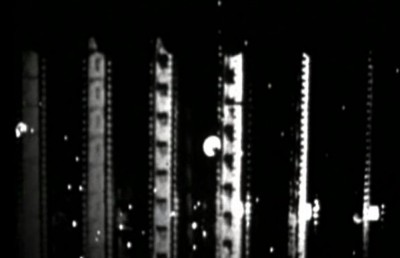The Cinematic Poetry of Bill Morrison
The Old Made New
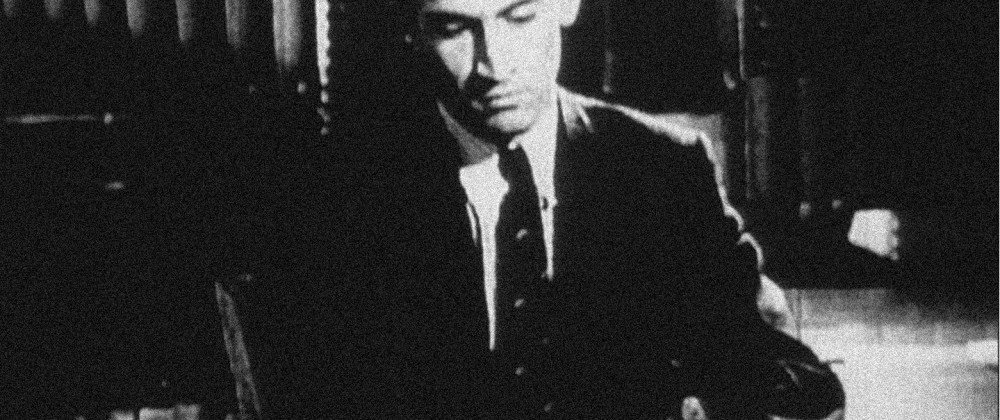
Bill Morrison Programme 1 (April 28, 2004)
The Night Highway (1990 9”), Lost Avenues (1991, 6”), Photo Op (1992 5”), Footprints (1992, 6”), The Death Train (1993, 17”), The World is Round (1994, 5”), Nemo (1995, 6”), Ghost Trip (2000, 23”), The Film of Her (1996, 12”), Trinity (2000, 12”)
Bill Morrison Programme 2 (April 29, 2004)
The Mesmerist (2003, 16”), Light is Calling (2003, 8”), Decasia: The State of Decay (2002, 67”)
This essay is a response to having seen a two programme retrospective of Bill Morrison’s work on April 28 and April 29, 2004 at La Cinémathèque Québécoise. The event was programmed by Offscreen’s French language sister magazine Hors Champ. Morrison was present on both nights to introduce the films and respond to audience questions. My thoughts will gravitate toward an impressionist overview of the series of (mainly) shorts which were projected across the two evenings. Although I am writing this several months after having seen the films, I am basing these ideas on scattered notes I took upon viewing the films and the opportunity I had to view a few other Morriosn short films which were not part of the programme (City Walk, The East River). Some of my notes were scribblings uttered by Morrison as a response to his own work, but the strange thing is that each film left its own indelible image (in some cases just that, a single image) in my mind, without my always being able to match the image to a particular film title.
If you have heard of Bill Morrison it is probably in relation to his feature film Decasia: The State of Decay (2002), and his process of taking pre-existing footage from films which have been largely lost to the natural process of nitrate deterioration, and reconstituting them as artifacts for a new artistic product. Although it would be unfair to reduce Morrison’s works to the fallibility of film’s materiality, or ‘ruined’ cinema, several of the most impressive works in the programme do rely heavily on the materiality of film, and the creative strength to take what would otherwise be seen as ‘destroyed’ or seriously compromised original footage and bring them to a new aesthetic existence (a new aesthetic form, rebirthism?). Films in the program that relied on deteriorated footage were Decasia: The State of Decay (2002), the only feature length film screened during the programme, and two shorts which were generated from the same source film, The Bells (1926, James Young), The Mesmerist (2003) and Light is Calling (2003). Other Morrison films could be categorized as ‘found footage’ films (The Film of Her, 1996, Trinity , 2000; and of course the ‘ruined’ films are also found footage films.) The Film of Her is one of Morrison’s most outstanding works, a personal, cerebral, yet moving experimental-documentary about the forgotten legacy of the Library of Congress clerk, Howard L. Walls, who rediscovered the paper print collection in 1939, which enabled Kemp Niver to restore them to safety acetate stock in the early 1950s.1 Some of the other films are in a more conventional tradition of abstract formalism (The Night Highway and City Walk, two wonderful companion pieces). The East River and The Death Train have more in common with the mytho-poetic films of the 1950’s and 1960s and later American and Canadian landscape films. While the enchanting ‘neo-Gothic’ noiresque Ghost Trip is a representational, big screen (cinemascope) experience with characters and a semblance of a plot.
The opening images of the programme were appropriate, not only in the chronological sense since The Night Highway was the earliest film in the programme, but in the sense of inviting us into Morrison’s ‘trip’: the black and white images begin with white vertical scratches which give way to manipulated white line fever shots which arch and curve along with the road (was it actually shot on the road or wholly optical?). The notion of a ‘trip’ is common across several of Morrison’s films, including City Walk, The East River, and Ghost Trip. In City Walk the urban travel imagery is manipulated to give the impression of a stark, charcoal-like chiaroscuro black and white. (And in fact, after writing this I noticed in the credits that the film was an excerpt from The Ridge Theatre staging of a play called “The Carbon Copy Building.”)
The subject is city movement, with the camera, situated in a moving vehicle, filming busy urban life (people on sidewalks, moving vehicles, buildings, and bridges). The texture of the image at times becomes so porous it recalls Georges Seurat’s pointillism. The constantly moving imagery, at times blurred, is greatly enhanced by the music. In fact the function of music in most of Morrison’s work shares equal importance with the image (if not more). This is something which Morrison was quick to point out and reiterate several times, reminding us on several occasions that many of his films were created as part of a multi-media art project which includes the experimental troupe Ridge Theatre and contemporary music composer Michael Gordon, whose work is a large factor behind the visceral impact of Morrison’s films (I’m thinking especially of the throbbing, industrial-symphonic score to Decasia). In City Walk the music begins with an edgy guitar, and then layered with a tinkling, minimalist piano and female voicing. As the film progresses the music becomes ‘thicker,’ more complex, with throbbing, low end piano chording and recurring percussive guitar stabbings. This precise, staccato rhythm forms a contrast to the blurring imagery.
The notion of a trip appears in The East River (2003, 5 minutes), which makes for a different experience from any of the other Morrison films I’ve seen. The ‘trip’ is of a more conventional subjective nature, with the (video) camera (and sound) bringing the viewer into an unseen character’s physical experience of swimming. As the film begins –this time the film makes aesthetic use of color– we see water droplets on the camera lens. The camera tracks along with a pair of feet walking along the banks of the East River. The sound of footsteps are prominent as the camera tracks past a mesh fence, panning past the concrete embankment largely submerged under water, catching a brief glimpse of a person’s shadow on the concrete wall and a bridge in the background (recalling if only for these scattered elements, Peter Rose’s The Man Who Could Not See Far Enough (1982). We hear the sound of a loud splash –the character has jumped into the river- with the camera following. For the remaining few minutes of the film the camera tilts, pans, and moves (hand-held I would think) its position and level in relation to the water between complete submersion, water level, and above water. In this section of the film the camera explores gorgeous underwater color effect patterns affected by the refracted sunlight.
There is one wonderful fleeting moment of happenstance which verifies the ontological truth of what we are seeing: in one of the camera’s underwater moments a large ant or insect floats past the left side of the camera lens.
The movement of the camera is also, throughout the film, slowed down to register a stuttered physical sensation. The film ends when the camera emerges out of the water at roughly the point of entry, bringing an end to the ‘trip.’
Although different from his other films, East River is not without precedence. If not a sheer coincidence (since I have not had this confirmed by Morrison), I would say that the film is strongly influenced by two similarly themed Barbara Hammer films, Pools (1981, co-directed by Barbara Klutinis) and Pond and Waterfall (1982). Pools is an exploration of the architecture in and around two of the twenty pools designed for Heart Castle in San Simeon by Julia Morgan, the first female American architect. A stronger influence seems to be Pond and Waterfall which is a slow motion exploration of the underwater vegetation and the shimmering effects of refracted sunlight off/under the water. Like East River, Hammer’s camera appropriates the subjective position of a person moving through water.
The notion of a trip, or a limbo state, is given a more dramatic/narrative shape in Morrison’s only fully representational film, Ghost Trip (2000), which uses a high contrast black and white stock with an extreme wide angle lens, slow motion cinematography, and image looping, to render the sense of a slow descent into another dimension. The film opens with a low angle shot of an old black man in a cemetery singing an ode to someone who comes back from the dead (“the man has arose…”), while planting a variety of flowers and vegetation. The film follows a hearse driver as he picks up a corpse in New Orleans and ends up back at the same cemetery (circular structure). Morrison referred to this film as reflecting an “existential limbo,” which can apply to many of his works, including The Death Train (1993).
The Death Train recalls the work of Al Razutis in its interest in film history, and Bruce Baillie, with its dreamy superimpositions and slow lap dissolves and transitions between aerial shots of a nightscape and phantom rider shots moving in and out of a tunnel (in particular, Baillie’s Castro Street and The Mass of the Dakota Sioux). The Death Train concludes with a rhythmically hypnotic montage of an optically manipulated mushroom cloud which pulsates and throbs in unison with the sound effects. The sense of an apocalypse returns at the end of Trinity (2000), which is, as much as anything, Morrison’s Man With a Movie Camera (Dziga Vertov, 1928), with its play between fiction/non-fiction, recurring use of graphic formations (roundness being the dominant) and industrial technologies (trains, automobiles, gear-driven industrial machines). The film is divided into three sections: 1) Memory 2) Sin 3) Desire. The central recurring image is found footage from a soft-core porn film of a woman who undresses (in section one), masturbates while reading a book (in section two), and lies nude in a seductive supine position, as if awaiting her lover (in section three). (I think it is the same woman in all three cases, though can’t be certain.) Joining these erotically charged images are industrial/machinic imagery (a movie projector, editing table, and factory machines). In Vertov’s film the utopian vision of human eye and camera eye was an artistic argument for a new perceptual process to take hold in the post-Revolution Soviet society. By contrast, Morrison’s fusion of human and machine is purely sensual and sexual. The sound is important throughout to this meaning, most tellingly during a key moment in this human-machine sexual symbiosis. The moment begins with a long shot of a woman masturbating while reading a book. The sound is a low vibrating hum, accompanied by a (Lynchian) scratched record and a high pitched electronic whir (the hiss and pops of the revolving record forming an aural equivalent to the imperfections coating the image track –scratches, dirt, hair, and grime). The image cuts to an extreme close-up of what looks like the woman’s hand, moving rhythmically. The music now assumes an electronic crescendo of machinic sounds, music, and a squeal, culminating in a musical-aural ‘climax.’
Trinity
I would like to conclude with a discussion of Morrison’s ‘rebirthism’ or ‘ruined’ cinema entries. As noted, two of the films draw from different elements of the same ‘deteriorated’ film, The Bells, The Mesmerist and The Light is Calling. Both films have sections where the condition of celluloid deterioration is such that the original image is barely recognizable. Of the two the latter contains more of these moments, while The Mesmerist relies more on the original’s narrative and representational qualities. That being said the celluloid ‘state of decay’ impacts greatly on the overall sensorial experience of both films. The ‘narrative’ of The Mesmerist deals with an amusement park Caligari-like mesmerist, played by a young Boris Karloff, who has the power to hypnotize people and make them reveal things about their past. In the crowd is Lionel Barrymore, who we later learn is a hotel proprietor with a dark cloud in his past. The condition of these opening crowd scenes are poor, greatly affected by deterioration, but casts an unusual ‘otherworldly’ quality to the otherwise benign scene. The image is further estranged by two not entirely complementary visual effects: slow motion (achieved by printing the original frame three or four times) and the strange impression created by the deterioration which makes the image seem like it is pulsating, breathing, bending, and weaving.
The mesmerist dares someone to join him on stage, and eventually the Barrymore character is on stage. The mesmerist hypnotizes the Barrymore character, who then recounts, in flashback, an incident from his past where he meets a Polish Jew at his hotel who is travelling with a belt full of gold. In terrible debt, the Barrymore character follows the rich traveller out into the night and murders him for the gold (the murder is suggested by drops of blood spilling onto clean snow). What is striking is how well preserved these ‘flashback’ scenes are in comparison to the other scenes. The effect, intentional or not, is that the material condition of the film becomes a structural component: distorted and ruined for the ‘present’ scenes and well preserved and clean for the ‘flashback’ scenes. This structure brings the original film, The Bells, even closer structurally and aesthetically to the film it obviously draws from, The Cabinet of Dr. Caligari (1919, Robert Weine), which contains a similar structure of fantasy/reality which is treated different aesthetically.
In The Light is Calling all that we can make out from the extreme deterioration are shots of officers on horseback riding through the woods, and a young woman with long braids who is found and aided by the officers at the end of the film. An interesting observation I had while watching the three ‘deteriorated’ films is that no matter how great or advanced the distortion and deterioration, there is one inevitable constant: the distortion is always in the foreground of the image. This leads to an equally interesting ‘formal’ and stylistic quality, because regardless of how flat the original footage may have been, the distortion introduces an element of ‘depth’ and ‘texture’ to the frame. This is especially noticeable in The Light is Calling, where the characters (the horseback officers and the woman) always appear to be ‘behind’ something. For example, in one scene we see the woman in long shot and, because of the formation of the deterioration, she appears to be peering through what looks like a fire or a cloud formation.
“Depth” in Light is Calling
“Depth” in Light is Calling
The greatly deteriorated passages where the film stock seems cindered and scorched, at times appearing like a moving Rorschach chart or Mandelbrot set, recalls Stan Brakhage’s hand painted films as well as his theory of “closed eye” vision. The visceral nature of the imagery also reminded me of a live performance piece by two German multi-media artists (Alchemie) during the 1997 FCMM, where they literally poured chemicals and compounds onto a film loop before it passed by the projector lens, throwing an unpredictable and volatile series of light and color patterns onto a wall, and culminating with the projector catching fire.
Hand-painted or deteriorated? Light is Calling
“Depth” in The Mesmerist
The extremely different music which accompanies these two films is representative of both the aesthetic range and importance of music in Morrison’s films. For The Mesmerist Morrison uses two existing Bill Frisell songs (“Tell you ma, tell your pa” and “Again”); and for The Light is Calling he uses a composition written exclusively for the film by Michael Gordon. What these two choices broadly represent are scores which have an organic relationship to the image track (The Light is Calling, Trinity, Ghost Trip, City Walk) and scores which interact with or against the image track (The Mesmerist, The Film of Her, with Decasia operating on both levels). Bill Frisell is a contemporary guitarist-composer who is no stranger to film music, having written several interpretative scores for Buster Keaton films. His musical style is an intellectual blend of jazz, blues, folk, country, and rockabilly, a postmodern eclecticism which, on the one hand, can be seen as a parallel to Morrison’s own re-appropriation of film history. But the clearly modern, contemporary feel of his music makes it feel as if it is playing to the film rather than alongside the film, and emanating from without the film rather than within the film. On the other hand, the pitch and rhythm of Gordon’s haunting combination of an undulating electronic loop and high pitched violin is a perfect harmony to the ??The Light is Calling??’s overall sense of a spiritual or transcendental rise.
At 67 minutes Decasia is Morrison’s found footage/’ruined’ cinema magnus opus. And while barely feature length, the overall experience is of such great intensity –with Michael Gordon’s incredibly loud, throbbing symphonic soundtrack threatening to melt the imagery- that one loses the sense of any objective time. As the film’s credits begin we hear what sounds like whirring Steenbeck plates. The film moves from a shot of a dervish dancer to a film lab, reflexively suggesting the birth and creation of the ‘film within a film.’ The film’s circular structure begins and ends on the same image of a dancing dervish, which links up the many recurring motifs of birth, death, and the apocalypse. In between there are images that range from ominous beauty (falling bomb-like parachutes) to painterly beauty (panoramic silhouette long shots of men on camels walking across a desert landscape).
Like The Mesmerist and The Light is Calling, there are some stunningly beautiful deteriorating images in Decasia: frames that pulsate, burn, and blur, like ‘moving visual poetry.’ Some of the ‘natural’ distortion and deterioration in Decasia (and the other films) was so aesthetically entrancing that I was very surprised to hear Morrison say that the original film footage was not doctored at all, other than being rephotographed or slowed down. If so, this is quite an aesthetic statement on the importance of time as a creative act. There is no better response to Henri Bergson’s ‘cinematographical mechanism,’ which sees time as a mechanistic and predetermined element. In response to this, time in Decasia is not arbitrary, but essential. The result is a different conception of cinematic time, not structural but ontological (and geological). This consideration of deterioration as a vital aesthetic quality is more attuned to Eastern culture, India for example, where buildings, places of worship, or monuments are allowed to crumble, as opposed to the West, which is fixated on making things anew and dedicated to preservation and restoration (a fear of loss of memory?). If Decasia works as a total experience, one can not separate its components from the many layers of ‘time’ which are a necessary condition of its ‘Being.’
[1] For an excellent account of Morrison’s The Film of Her and its relationship to film history I recommend the essay, “Archives and Archivists Remade: The Paper Print Collection and The Film of Her by Gabriel M. Paletz. The Moving Image. Vol. No. 1 (Spring 2001): 68-93. Also, in the Morrison film he cites 1939 as the year that Walls rediscovered the Paper Print Collection, and 1954 as the year when Kemp Niver received a special Academy Award for his role in the restoration of the Paper Print Collection. According to writer Paletz in the above noted essay, the actual years were 1942 for Walls’ rediscovery and 1955 for Niver’s Academy Award.



